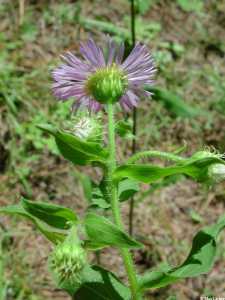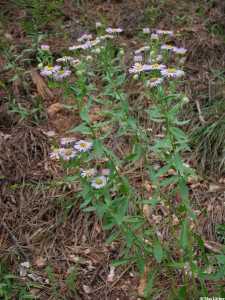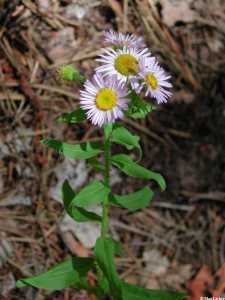Perennials 30-80 cm; rhizomatous to subrhizomatous, fibrous-rooted, caudices usually relatively short and few branched, thick, woody. Stems erect, sometimes sparsely pilose (hairs 1-2 mm), densely stipitate-glandular. Leaves basal (usually withering by flowering) and cauline; basal blades oblanceolate-spatulate, 30-80 × 5-20(-25) mm (bases usually clasping to subclasping), margins entire, faces glabrous, densely stipitate-glandular; cauline blades narrowly lanceolate to oblong-, ovate-, or elliptic-lanceolate, nearly even-sized distally or sometimes mid largest (continuing to immediately proximal to heads). Heads 1-15(-22) in corymbiform arrays. Involucres 6-9 × 10-15(-18) mm. Phyllaries in 2-3(-4) series, densely stipitate-glandular. Ray florets 75-150; corollas blue to lavender, 9-17 mm (ca. 1 mm wide), laminae coiling. Disc corollas 3-4 mm. Cypselae 1.7-2 mm, 2-nerved, faces sparsely strigose; pappi: outer of (conspicuous) scales, inner of 14-22 bristles. 2n = 18.
Flowering Jul-Sep(-Oct). Openings and open woods, oak-pine, ponderosa pine, pine-fir; (1300-)1800-3100 m; Ariz., Colo., N.Mex.; Mexico (Sonora).
Erigeron vreelandii is similar to E. speciosus in its perennial duration, tall stature, subclasping, spreading leaves nearly even-sized up the stems, corymbiform arrays, and blue rays; it is distinguished by the prominent vestiture of relatively long stipitate-glandular hairs. Intermediates apparently are formed between the two.
Duration: Perennial
Nativity: Native
Lifeform: Forb/Herb
General: Herbaceous perennials to 80 cm tall, stems simple or branching, relatively few, arising from a stout, woody caudex with rhizomatous and fibrous roots.
Leaves: Alternate, basal leaves usually withering by flowering, oblanceolate to spatulate, to 80 mm long and 20 mm wide, bases usually clasping to subclasping, margins entire, faces glabrous, densely stipitate glandular, cauline leaves narrowly lanceolate to oblong, ovate, or elliptic-lanceolate, not much reduced.
Flowers: Heads radiate, the rays blue to lavender, 75-150, 9-17 mm long, coiling, disks yellow, involucres 6-9 mm high, 10-15 mm wide, phyllaries in 2-4 series, densely stipitate glandular, heads 1-15, borne in corymbiform arrays.
Fruits: Achenes 2 nerved, sparsely strigose. Pappus in 2 series, the outer of conspicuous scales, the inner of 14-24 bristles.
Ecology: Found on rich soils in coniferous forests, open woods, oak-pine, ponderosa pine, and pine-fir communities, from 4,000-9,000 ft (1219-2743 m); flowering July-October.
Distribution: Arizona, Colorado and New Mexico; Mexico.
Ethnobotany: Unknown, but other species in the genera have uses.
Etymology: Erigeron means Early-Old-Man, as named by Theophrastus, while vreelandii is named for Frederick King Vreeland, who collected in the United States from 1883-1932.
Synonyms: Erigeron platyphyllus
Editor: SBuckley, 2010, LCrumbacher






